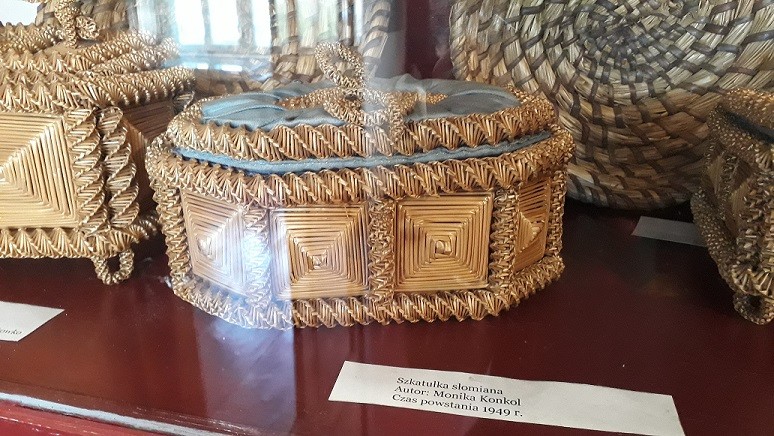I stumbled upon them on the first floor of the Franciszek Treder Kashubian Museum in Kartuzy. They stood enclosed in a display case surrounded by other wickerwork - baskets, trays, and even handbags and a pair of sandals, whose style was no less fashionable than the trends of contemporary streets. Three straw boxes, as they are the heroines of this text, however, stood out from the other items due to their previously unseen form in Kashubian craftsmanship.
Basket weaving in Kashubia is mainly various types of baskets, but also straw hives (baskets), barrels, buckets, armchairs, chairs, sleds, shoes for warming the feet during frosty rides, or straw hats and star cloaks. They were woven from wicker, pine roots, juniper, pine bark, and straw. These products are characterized by the simplicity of shapes, which better highlights their interesting texture and good proportions. The straw caskets seem to contradict the above – they are very decorative, with spiral frames of the construction (resembling baroque columns with a twisted shaft) and a delicate handle on the lid, additionally lined with silk lining. Information placed on the catalog card of one of the boxes confirms its originality: "The technique described in the above-mentioned item has not been used in the production of caskets so far."
At the same time, I was intrigued by a plaque placed next to the exhibits, which indicated that their creator is... my grandfather's sister. A short family discussion was enough to confirm this thesis. Indeed, Aunt Monika's (now deceased) passion was creating such decorative straw boxes. From my grandmother's accounts, the aunt acquired this skill from a Ukrainian woman who served post-war at a manor in the village of Kożyczkowo in Kashubia, with whom she met while grazing cows. She was the only one in the area who wove them, for herself and her loved ones. This fact is also confirmed by my mother - she received a straw casket as a gift on the occasion of her First Communion; to this day, she does not hide her resentment, as, like all her peers, she hoped for a watch.
Continuing the thread of the Ukrainian woman known in the village, a new lead for the search was indicated by reading the compendium Folk art in the Soviet Union. A nearly identical straw casket, like those from the Kashubian Museum, appears in the chapter on Belarusian art. From it, we learn, among other things, that in the past in Belarus, various household items such as boxes or bread baskets were woven from straw, and that local craftsmen present a characteristic style not found outside the country's borders. One can therefore assume that the Ukrainian woman from my grandmother's story was actually Belarusian, and as a result of events that we will probably never get to know, she found herself in Pomerania, where she left a fragment of her culture.
Location: Kożyczkowo (Kartuzy district, Chmielno commune)
Date and place of execution: 1949, Kożyczkowo
Author's name: Monika Konkol
Prepared by: Agnieszka Domańska
I would like to thank Mrs. Barbara Kąkol from the Kashubian Museum in Kartuzy for sharing information about the exhibit.
Sources:
Folk art in the Soviet Union, T. Razina, N. Cherkasova, A. Kantsedikas, Aurora Art Publishers, Leningrad 1989

